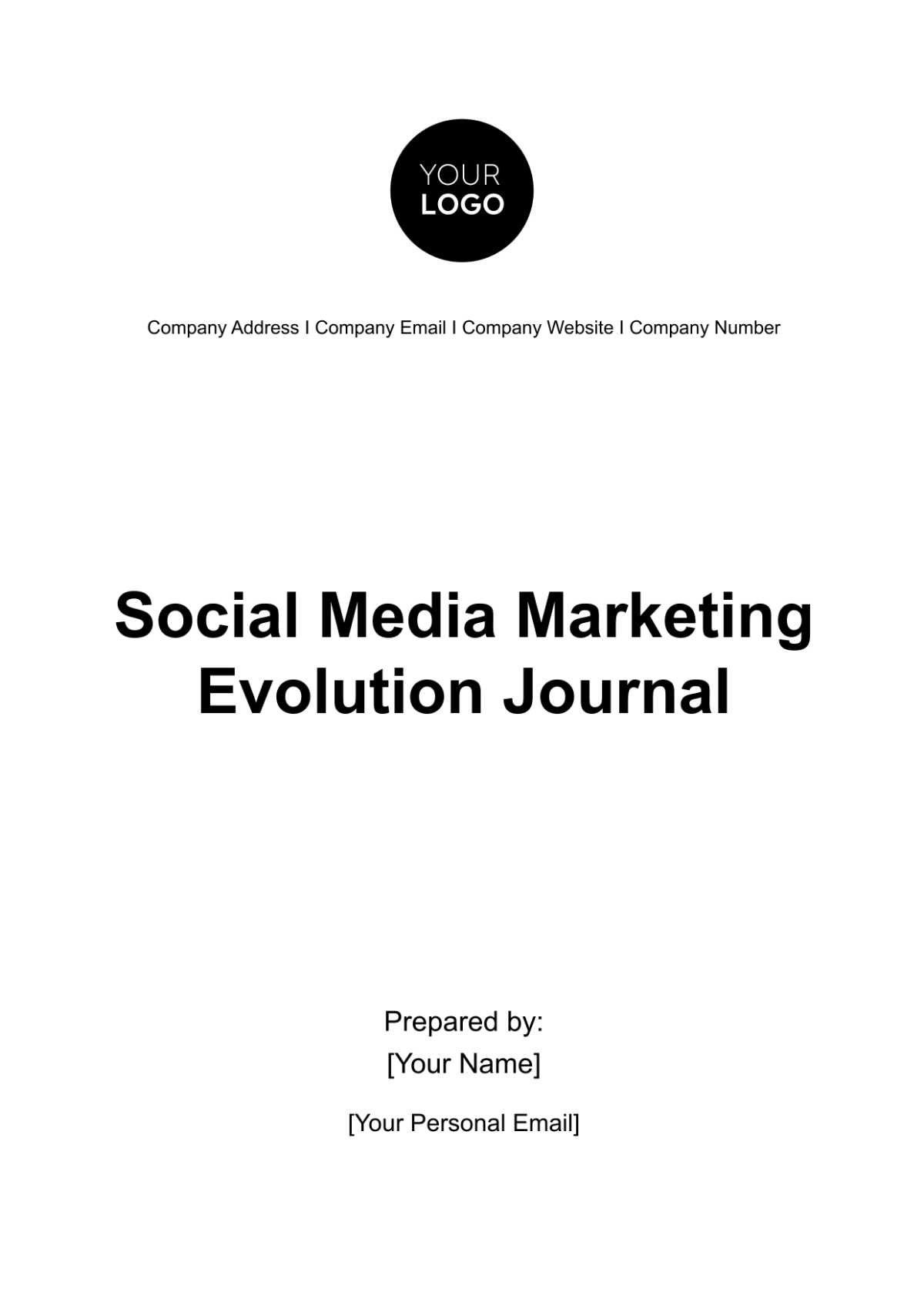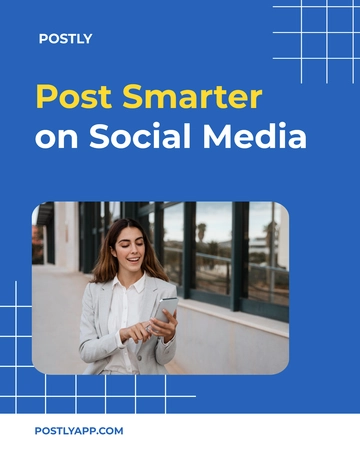Free Social Media Marketing Evolution Journal

I. Introduction to Social Media Marketing Evolution
In the ever-shifting digital landscape, the evolution of social media marketing stands as a testament to the ceaseless transformation of our industry. To embark on this journey of exploration, it's essential to grasp the profound impact that social media marketing has had and continues to have on our field. Social media marketing is more than just a trend; it's a dynamic and transformative force that continually shapes the way we connect with our audience and achieve our marketing objectives.
A. The Transformation of Marketing
Picture a time when marketing was a one-way street—a monologue where brands spoke, and consumers listened. That era has been reshaped by the emergence of social media. It's not just a revolution; it's a transformation in the truest sense.
The rise of platforms such as Facebook, Instagram, Twitter, and LinkedIn has fundamentally altered the marketing landscape. It's no longer about merely conveying our message; it's about engaging in a dynamic, two-way conversation with our audience. Social media has turned consumers into active participants, not passive spectators.
Consider the statistics: Facebook, with over 2.8 billion monthly active users; Instagram, with more than 1 billion; Twitter, with its real-time engagement; and LinkedIn, the professional networking hub with 774 million members. These platforms aren't just numbers; they are vibrant ecosystems where brands and consumers coexist.
But this isn't just about numbers; it's about the qualitative shift in our approach. Social media has ushered in a new era where authenticity, engagement, and conversation reign supreme. It's not just about selling; it's about connecting. It's not just about broadcasting; it's about listening. It's not just about the brand; it's about the community.
As we delve deeper into the evolution of social media marketing, we'll explore the milestones, trends, and strategies that have shaped this transformative force. We'll equip you with insights and knowledge to navigate this dynamic terrain, where the only constant is change. So, let's embark on this journey to understand how social media marketing has evolved and how we can thrive in this ever-changing landscape.
II. Milestones and Key Trends in Social Media Marketing
In the ever-evolving landscape of social media marketing, understanding the significant milestones and key trends is akin to navigating the milestones of history. This section is our guide through the annals of social media marketing evolution, where each milestone represents a pivotal moment that has shaped the industry. Let's embark on this journey through time to explore how social media marketing has grown and transformed.
A. The Early Days: Emergence of Social Media Platforms
In the early 2000s, social media was a nascent concept. Friendster and My Space were among the pioneers, laying the foundation for the digital social landscape we know today. Marketers, curious and cautiously optimistic, tiptoed into these virtual spaces, testing the waters of brand presence on social media.
B. Rise of Facebook and Twitter
The mid-2000s marked a significant turning point with the emergence of Facebook and Twitter as global giants. These platforms swiftly gained popularity, and marketers realized the potential they held. Branded pages emerged, and Twitter advertising became a new frontier. Social media marketing was no longer a novelty; it was a necessity.
C. Visual Revolution: Instagram and Pinterest
As the digital world evolved, so did the way we consumed content. The 2010s ushered in the visual revolution. Instagram and Pinterest took center stage, captivating audiences with visually appealing content. Visual storytelling became paramount, and marketers had to adapt. From striking imagery to captivating infographics, visuals became the language of engagement.
D. Video Dominance: YouTube and TIKTOK.
In this era, video content seized the throne. YouTube, the colossal video-sharing platform, evolved into a content powerhouse, with billions of hours of video viewed daily. But the true disruptor was TIKTOK. This short-form video platform took the world by storm, changing how we consume content and engage with brands. Video content emerged as a formidable force, demanding marketers' attention to resonate with modern audiences.
As we delve into each milestone and explore the key trends that have shaped the journey of social media marketing, you'll gain insights into the forces that have propelled us forward. It's a journey of adaptation, innovation, and staying ahead of the curve. By understanding these pivotal moments, we equip ourselves to navigate the ever-changing tides of social media marketing with agility and wisdom.
III. Impact on Marketing Strategies and Practices
The evolution of social media marketing has had a profound impact on how businesses approach their marketing strategies and practices. This section serves as a guide to understanding how social media's growth has reshaped the very foundations of marketing, ushering in a new era of customer-centricity and real-time engagement. Let's delve into how these seismic shifts have transformed our approaches.
A. From Push to Pull Marketing
Traditionally, marketing followed a push strategy where brands would create messages and advertisements and then "push" them out to a broad audience through various channels. This approach was largely one-way communication, with brands attempting to persuade consumers to buy their products or services. However, the emergence of social media brought about a significant shift in this paradigm.
Social media platforms created an environment where consumers could actively engage with brands and each other. Instead of relying solely on pushing messages, marketers now had the opportunity to pull consumers in through engaging content and interactions. Here's how this shift has impacted marketing strategies:
Engaging Content: Brands began to focus on creating content that was not just promotional but also entertaining, informative, or valuable to their target audience. This approach aimed to capture the audience's interest and encourage them to engage with the content. |
Genuine Interactions: Social media encourages brands to interact genuinely with their followers. This meant responding to comments and messages, participating in conversations, and showing a human side. Authentic engagement became a key element of successful social media marketing. |
Customer-Centric Approach: Instead of talking to customers, brands started listening to them. Social media provides a platform for feedback, complaints, and suggestions from customers. Brands could use this valuable input to improve their products or services. |
Building Communities: Many brands focused on building online communities or forums where customers could connect with each other, share experiences, and discuss topics related to the brand. These communities often fostered a sense of belonging and loyalty. |
B. Personalization and Micro-Moments
Data-Driven Targeting: Social media platforms collect a wealth of data on users' interests, demographics, and behaviors. Marketers can leverage this data to create highly targeted ad campaigns. For example, they can show ads to users who have previously visited their website or have shown interest in similar products. |
Content Tailoring: Marketers began tailoring their content to specific audience segments. This meant creating content that resonated with the unique interests and preferences of different groups. Personalized content often leads to higher engagement and conversion rates. |
Micro-moments, on the other hand, represent opportunities for brands to engage with consumers at crucial decision-making points. These moments can occur when someone searches for a product, reads reviews, or seeks information. Here's how micro-moments impact marketing:
Real-Time Marketing: To capitalize on micro-moments, marketers need to be responsive and provide relevant information promptly. This might involve running ads or creating content that addresses consumers' immediate needs. |
Mobile Optimization: Many micro-moments occur on mobile devices. Brands need to ensure that their websites and content are mobile-friendly to deliver a seamless experience. |
C. Influencer Marketing and User-Generated Content
Influencer marketing and user-generated content have become powerful tools for building trust and authenticity.
Influencer Partnerships: Collaborating with influencers who have a significant following in a specific niche or industry can extend a brand's reach and credibility. Influencers can authentically promote products or services to their engaged audience. |
User-Generated Content: When satisfied customers create content showcasing their experiences with a brand's products or services, it serves as authentic social proof. Brands can share this content on their platforms or websites, boosting trust and credibility. |
The impact of social media on marketing strategies and practices is undeniable. It has shifted the focus from one-way communication to genuine engagement, emphasized personalization and real-time responses, and introduced influential voices and authentic user-generated content into the marketing mix. Adaptation to these changes has become crucial for brands looking to thrive in the social media era.
IV. Challenges and Opportunities
Navigating the ever-evolving landscape of social media marketing presents both challenges and opportunities. Let's delve into these aspects, beginning with the challenges and then exploring the opportunities they present.
A. Privacy and Data Concerns
Challenges
Data Privacy Regulations: The increasing scrutiny on data privacy has led to the enactment of stringent regulations like GDPR and CCPA. Complying with these regulations can be complex and require substantial resources. |
User Trust: Data breaches and misuse of personal information erode user trust. Rebuilding trust in an era of heightened privacy concerns is challenging, but vital for maintaining brand credibility. |
Transparency: Social media users demand transparency regarding data collection and usage. Brands must be transparent in their data practices, which can be a balancing act between data-driven marketing and transparency. |
Opportunities
Building Trust: Brands that prioritize data security and transparent practices can build trust with their audience. Highlighting strong data protection measures in marketing communications can set a brand apart. |
Customer-Centricity: Privacy concerns present an opportunity for brands to adopt a customer-centric approach. By respecting user preferences and being transparent about data usage, brands can forge stronger connections with their audience |
Data-Driven Insights: Ethical data collection and analysis provide valuable insights into customer behavior. Leveraging data responsibly can help refine marketing strategies and create more personalized, effective campaigns. |
B. Content Saturation and Algorithm Changes
Challenges
Content Overload: Social media platforms are flooded with content, making it increasingly challenging for brands to stand out. Competition for users' attention is fierce. |
Algorithm Uncertainty: Social media algorithms are continually evolving, affecting the visibility of content. Sudden algorithm changes can disrupt established marketing strategies. |
Quality vs. Quantity: Striking the right balance between producing a high volume of content and ensuring its quality is a constant challenge. Brands must create content that resonates with their audience to remain relevant. |
Opportunities
Quality over Quantity: Content saturation underscores the importance of quality content. Brands that prioritize producing valuable, well-crafted content can rise above the noise and capture their audience's attention. |
Storytelling: Storytelling has become a potent tool in content marketing. Brands that tell compelling stories can create emotional connections with their audience, making their content more memorable and shareable. |
Adaptability: The dynamic nature of social media algorithms presents opportunities for agile marketers. Brands that can quickly adapt to algorithm changes can capitalize on new trends and opportunities as they arise. |
In summary, the challenges posed by privacy and data concerns, as well as content saturation and algorithm changes, are countered by opportunities for brands to build trust, adopt a customer-centric approach, and focus on quality content and storytelling. Successful navigation of these challenges and seizing the associated opportunities is crucial for long-term success in social media marketing.
V. Future Prospects and Predictions
A. Embracing Emerging Platforms
The future of social media marketing promises exciting opportunities, marked by the emergence of innovative platforms and technologies. As we delve into the prospects and predictions for the industry, it becomes evident that staying ahead requires a proactive approach to embracing these new horizons.
Virtual Reality (VR) and Augmented Reality (AR): The integration of VR and AR into social media platforms is expected to create immersive experiences for users. Marketers can leverage these technologies to provide interactive product demonstrations, virtual store tours, or gamified content. For instance, AR filters and lenses on platforms like Snapchat have already demonstrated their engagement potential.
The Metaverse: The concept of the Metaverse, a shared virtual space merging physical and digital realities, is gaining traction. Companies like Facebook (now Meta) are investing heavily in building the metaverse. Marketers should explore how to establish a presence within this evolving landscape, potentially hosting virtual events, conferences, or immersive brand experiences.
Niche Platforms: The proliferation of niche social media platforms catering to specific interests and demographics offers unique opportunities. Brands should identify platforms aligned with their target audience's interests and values, enabling more precise targeting and engagement.
User-Generated Content in Emerging Platforms: Encouraging user-generated content on emerging platforms can be a powerful strategy. User-generated content fosters authenticity and community-building, which resonates well with modern consumers.
B. AI and Automation
Artificial intelligence (AI) and automation are transforming the social media marketing landscape, providing marketers with powerful tools to streamline operations, enhance personalization, and gain deeper insights into consumer behavior.
Chatbots and Customer Service: AI-driven chatbots are becoming increasingly sophisticated in handling customer inquiries and providing real-time support. They enhance the user experience by offering instant responses, freeing up human resources for more complex tasks.
Personalized Recommendations: AI algorithms analyze user data to deliver personalized content and product recommendations. This fosters a more tailored and engaging customer experience, increasing the likelihood of conversions.
Data Analysis and Insights: AI-powered analytics tools can process vast amounts of data to extract valuable insights. Marketers can use these insights to refine their strategies, identify trends, and make data-driven decisions.
Content Creation: AI can assist in content creation by generating text, images, and even video content. While human creativity remains irreplaceable, AI can speed up content production and assist in generating ideas.
C. Ethical and Sustainable Marketing
Consumers are increasingly conscientious about ethical and sustainable practices. The future of social media marketing hinges on brands aligning with these values to establish meaningful connections with their audience.
Transparency: Brands that embrace transparency in their operations and communication will resonate with consumers who seek authenticity. Being open about sourcing, manufacturing processes, and corporate responsibility efforts can build trust.
Sustainability Initiatives: Incorporating sustainability initiatives into marketing campaigns can have a profound impact. Highlighting eco-friendly practices, reducing waste, and supporting social causes demonstrate a brand's commitment to a better world.
Customer Engagement in Sustainability: Encouraging customer participation in sustainability efforts can foster a sense of community and shared responsibility.
Campaigns that involve consumers in eco-friendly activities or support charitable causes can create deeper brand connections.
Regulatory Compliance: Staying informed about evolving regulations related to ethical and sustainable marketing practices is essential. Non-compliance can result in reputational damage and legal repercussions.
In conclusion, the future of social media marketing holds exciting possibilities, from immersive technologies to AI-driven efficiencies and ethical brand values. Embracing these trends and staying agile in adapting to change will be the keys to success in the ever-evolving landscape of social media marketing.
Marketing Templates @ Template.net
- 100% Customizable, free editor
- Access 1 Million+ Templates, photo’s & graphics
- Download or share as a template
- Click and replace photos, graphics, text, backgrounds
- Resize, crop, AI write & more
- Access advanced editor
Chart your social media journey with Template.net's Social Media Marketing Evolution Journal Template. Capture insights, track trends, and set strategic goals effortlessly. Chronicle your growth, document successful campaigns, and refine your marketing approach. Elevate your online presence and evolve as a social media marketer with this insightful and customizable template.
You may also like
- Instagram Ad
- Instagram Banner
- Instagram Frame
- Instagram Post
- Instagram Profile Picture
- Instagram Story
- Instagram Story Highlights
- Twitter Ad
- Twitter Header
- Twitter Post
- LinkedIn Photo
- Linkedin Post
- YouTube
- Youtube Ad
- Youtube Banner
- YouTube Channel Art
- YouTube End Screen
- Youtube Profile Photo
- YouTube Thumbnail
- Facebook Ad
- Facebook Cover
- Facebook Post
- Facebook Profile Frame
- Facebook Profile Photo
- Twitch Offline Banner
- Linkedin Banner
- Twitch Overlay
- Whatsapp Status
- Reddit Banner
- Social Media Banner
- Social Media Clipart
- Social Media Plan
- Social Media Contract
- Social Media Planner
- Social Media Report
- Social Media Agreement
- Social Media Business Card
- Social Media Proposal
- Social Media Presentation





























